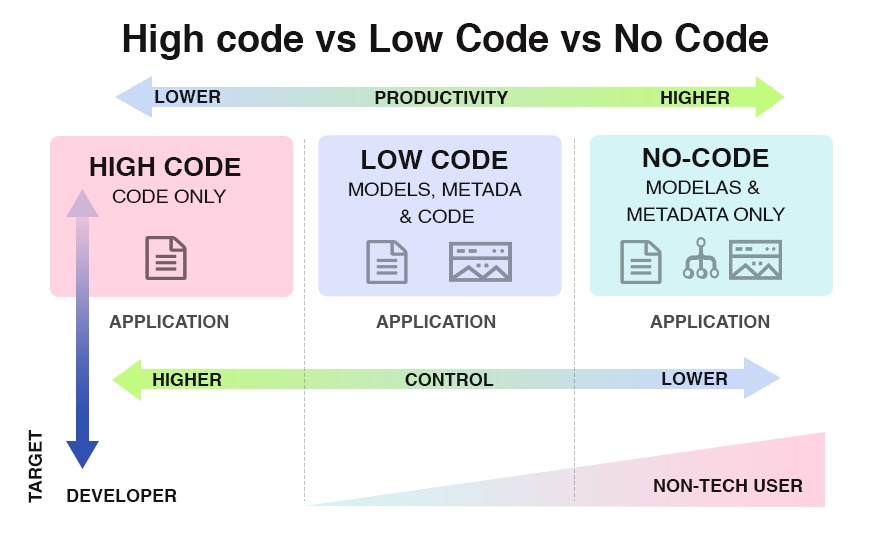
Easy! Effortless! Fast! Light! We are talking about the low code platforms that are resolving the dependence on developers in building applications. With market demand for mobile application development services getting to be 5x times the capacity of IT to deliver, low code apps are the future, particularly for small business enterprises.
According to Gartner the low-code development market was estimated to total $13.8 billion in 2021 (an increase of 23% from 2020) and Forrester Research says that low-code platforms are driving about 50% annual growth.
The business reasons for these low code application development platforms paint a rosy picture but are these platforms for everyone? Here is a look into why this trend is creating a buzz and the pros and cons of low code/no-code development.
What are low code solutions?
A low code solution provides a graphical user interface (GUI) to build web and mobile applications. Of course, the low code solution has been first built by a team of developers for others to use. Low code platforms are directed towards other developers, who need not develop solutions from scratch because LCDPs (low code development platforms) have a drag and drop functionality that automates every step of the application yet allows for some amount of customization.
No-code on the other hand is geared towards non-tech savvy users or citizen developers as they are known. These businesses or individuals can still use the low-code platform features, without the need to customize them.
The best examples of low code platform providers are WordPress, Google App Maker, Salesforce Lightning, Microsoft Power Apps, Appian, and more. As you can see, most of the big names have jumped into providing low code solutions that have found many takers.

A business use case that leverages low code technology
Many industries and start-ups have embraced low code solutions in developing and going to market quickly to solve their customer problems. One of the best use cases is that of Hortilux Schréder based in the Netherlands They are the market leaders in the development, supply, and applications of grow light solutions (LED, HPS and hybrid) for international greenhouse horticulture and indoor farming.
To improve its customer service and also to maintain its position as a global innovation leader, Hortilux embraced the Internet of Things (IoT) to provide smart solutions to its customers. They used the Mendix platform which is a low code application development platform, to create an app that provides insights regarding greenhouse performances and show them visually as graphs to their customers through data collected from sensors placed in the greenhouses. It took just two months to create an application called ‘Hortisense’ which was well received by growers and based on their feedback, Hortilux expanded Hortisense with new features via regular iterations and they still continue to grow.
Advantages of low code/no-code solutions
About 15% of companies are using these low code platforms to build their applications, the remaining are still going with traditional coding. The adoption rates of the former will keep on increasing because of these strong advantages.
1. Democratization of application development
Since these solutions offer visualized experience and tools to users, there is hardly any coding involved and dependency on a development team is reduced. Any end-user without coding experience can build and deploy their own applications. For example, an individual or business might want to add a form that receives input from a customer and submit this information to a business email id or CRM. All that needs to be done is drag and drop an input box and a button from the toolbox, fill in the prompts for handling the information, and voila it is done. As simple as that.
2. Fast development time
Since the power to build and deploy applications is in the hands of just about anyone, big development teams and the manpower costs that come with that are no longer a necessity. In fact, a full-blown application is ready to be deployed within 2 days to a week, depending on the complexity. There is no longer the need to build a solution from scratch, as in the case of custom or high code solutions, where the deployment and release cycles can be 75% longer.
3. Outstanding user experience
Outstanding user experience is what all applications strive for but many fall short. Low-code platforms come with prebuilt UI interfaces, a choice of templates with ready-to-use layouts and styles, along with add-on components and widgets that can easily integrate with each other and across devices. All these building blocks have already followed the best practices for intuitive user interfaces and have been intensively tested, so the end-user is assured of a great user experience.
Disadvantages of low code/no-code solutions
Think of it in terms of getting a customized designer outfit for a red carpet event compared to buying one off the rack. Yes, you have got it, there will be limitations to what you can do with low-code, and here they are
1. Limitations in customization
Developers will have full control over the high code or custom software solutions where they can customize it to the level that is needed. Whereas low code/no-code solutions rely on built-in functionality and available plugins. If you need to add new functionality, you might be stumped as there is no provision provided to build in new features. Before choosing a low code platform, it is important to understand the limitations of the features it provides. Not all low code tools are created equally.
2. Security vs Shadow IT
The simplicity and reduced cost of the platform makes it easier for individual departments in an organization to build their own apps without the IT team being looped in. For large organizations, this could mean leakage of sensitive data since they might not adhere to important technical, procedural, and industry-specific policies.
3. Vendor lock-in
The biggest fear is that once you develop your product on a specific platform then it is locked into the vendor they have chosen. While true in most cases, there are many exceptions and this is why it is important to go through the policy agreement with a fine-tooth comb.
Many vendors provide clean, standardized code that will work anywhere and so you can migrate your solution to another platform without any loss of functionality.
However, some vendors can lock you into their low code platform by generating convoluted code that cannot be maintained outside their platform. Other vendors will not allow you to edit your application once you have stopped your subscription.
Once you build an entire solution using the low code/no-code solution, it is hard to back out from that vendor or switch to high code or other solutions. Make sure that you can maintain your application outside the platform before you formally sign in to use the low code platform.
Will custom software be dead soon?
Amid the rising trend of low code/no-code solutions, is the death knell being sounded for custom software development as the preferred option? Far from it. Custom software development has its own distinctive place and low-code solutions cannot meet every business scenario.
Some business use cases require open-ended thinking. This means that functionality and structure can be open to change based on market needs or changing business strategies. Custom software solutions can adapt to such an undetermined structure whereas a low-code platform is highly structured and rules itself out for such use cases.
Similarly, if an application requires a high level of specialized interactivity then traditional software development is the choice. Most advanced apps have numerous features with a high level of personalization. Many businesses prefer to develop an MVP (minimal viable product) using a low-code platform so that they can quickly test the market for the application. Based on the inputs they collect, they might go in for an advanced product using a full team of developers.
There will always be innovation and the emergence of disruptive technologies that will require engineering effort. While low-code platforms will free up developers to work on more specialized solutions, the truth remains that software developers are not going to be replaced and Custom application development is here for the long run. The business software solutions as we know them today might evolve and change but both will co-exist.



